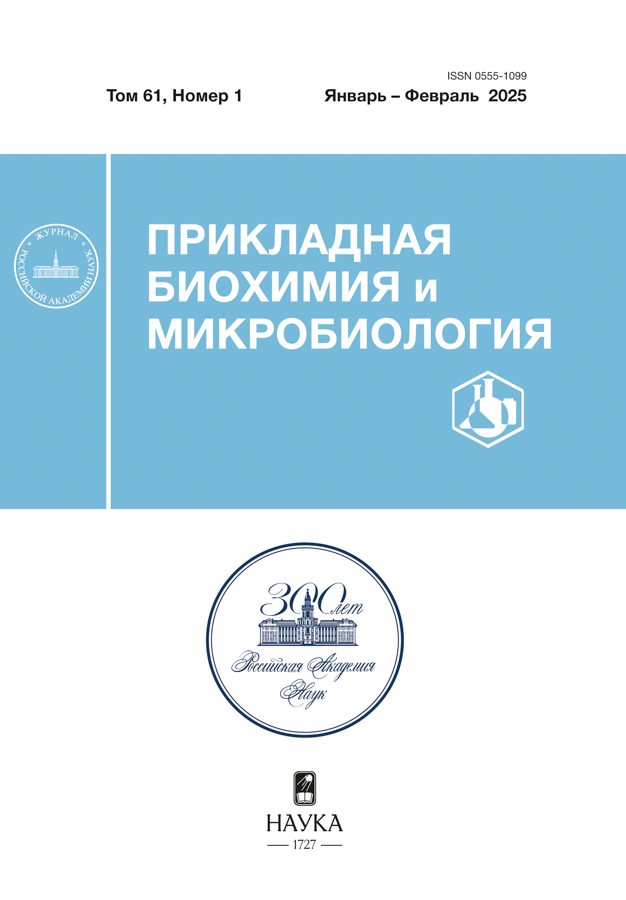Catalytic Properties of Immobilized Phytase of Silvania hatchlandensis FG 3.9.1
- Authors: Semenova K.G.1,2, Maksimova Y.G.1,3
-
Affiliations:
- Institute of Ecology and Genetics of Microorganisms, Ural Branch of the Russia Academy of Sciences, Perm Federal Research Center
- Perm National Research Polytechnic University
- Perm State National Research University
- Issue: Vol 61, No 1 (2025)
- Pages: 35-43
- Section: Articles
- URL: https://medjrf.com/0555-1099/article/view/683310
- DOI: https://doi.org/10.31857/S0555109925010044
- EDN: https://elibrary.ru/CZNNDX
- ID: 683310
Cite item
Abstract
A phytase preparation was obtained from the cells of haloalkalitolerant bacteria identified as Silvania hatchlandensis isolated from the soil of a soda sludge storage facility. When the enzyme was immobilized in barium alginate gel and cross-linked with activated chitosan, 97 and 95% of the native protein activity, respectively, was retained. It was shown that 70% of the phytase activity was retained when using the enzyme immobilized in alginate and bound to chitosan over 6 consecutive reaction cycles. Immobilization resulted in an insignificant decrease in the maximum reaction rate and a decrease in the Michaelis constant. Immobilized phytase was more thermally stable compared to the free form of the enzyme: the thermal inactivation constant of the immobilized enzyme at 70°C decreased by 1.1–1.2 times. The immobilized enzyme retained activity at pH 3–12; the pH optimum of the enzyme after immobilization did not change and was equal to 5.0. The specific activity of the enzyme covalently attached to activated chitosan is higher than that of the native enzyme in low and high pH environments. Immobilized phytase of haloalkalitolerant S. hatchlandensis can be used in feed production and other areas of agriculture.
Full Text
About the authors
K. G. Semenova
Institute of Ecology and Genetics of Microorganisms, Ural Branch of the Russia Academy of Sciences, Perm Federal Research Center; Perm National Research Polytechnic University
Author for correspondence.
Email: yul_max@mail.ru
Russian Federation, Perm, 614081; Perm, 614990
Y. G. Maksimova
Institute of Ecology and Genetics of Microorganisms, Ural Branch of the Russia Academy of Sciences, Perm Federal Research Center; Perm State National Research University
Email: yul_max@mail.ru
Russian Federation, Perm, 614081; Perm, 614068
References
- Singh B., Boukhris I., Pragya, Kumar V., Yadav A., Farhat-Khemakhem A. et al. // Pedosphere. 2020. V. 30. № 3. Р. 295–313. https://doi.org/10.1016/S1002-0160(20)60010-8
- Jain J., Sapna, Singh B. // Process Biochem. 2016. V. 51. Р. 159–169. https://doi.org/10.1016/j.procbio.2015.12.004
- Balwani I., Chakravarty K., Gaur S. // Biocatal. Agric. Biotechnol. 2017. V. 12. P. 23–29. https://doi.org/10.1016/j.bcab.2017.08.010
- Rizwanuddin S., Kumar V., Naik B., Singh P., Mishra S., Rustagi S., Kumar V. // J. Agric. Food Res. 2023. V. 12. 100559. https://doi.org/10.1016/j.jafr.2023.100559
- Urgessa O.E., Koyamo R., Dinka H., Tefese K., Gemeda M.T. // Int. J. Microbiol. 2024. V. 2024. 9400374. https://doi.org/10.1155/2024/9400374
- Li H.-P., Han Q.-Q., Liu Q.-M., Gan Y.-N., Rensing C., Rivera W.L. et al. // Microbiol. Res. 2023. V. 272. 127375. https://doi.org/10.1016/j.micres.2023.127375
- Zhou Y., Anoopkumar A.N., Tarafdar A., Madhavan A., Binoop M., Lakshmi N.M. et al. // Environ. Pollut. 2022. V. 308. 119703. https://doi.org/10.1016/j.envpol.2022.119703
- Li C., Wang Z., Bakshi S., Pignatello J.J., Parikh S.J. // Sci. Total Environ. 2021. V. 787. 147720. https://doi.org/10.1016/j.scitotenv.2021.147720
- Sharma S., Gupta P., Arya S., Kaur A. // Process Biochem. 2022. V. 120. P. 22–34. https://doi.org/10.1016/j.procbio.2022.05.022
- Karume I. // Sustainable Chem. Environ. 2023. V. 4. 100048. https://doi.org/10.1016/j.scenv.2023.100048
- Mrudula Vasudevan U., Jaiswal A.K., Krishna S., Pandey A. // Bioresour. Technol. 2019. V. 278. P. 400–407. https://doi.org/10.1016/j.biortech.2019.01.065
- Сердюк Е.Г., Исакова Е.П., Гесслер Н.Н., Трубникова Е.В., Антипов А.Н., Дерябина Ю.И. // Прикл. биохимия и микробиология. 2019. Т. 55. № 5. С. 498–505. https://doi.org/10.1134/S055510991905012X
- Filippovich S.Y., Isakova E.P., Gessler N.N., Deryabina Y.I. // Bioresour. Technol. 2023. V. 379. 129030. https://doi.org/10.1016/j.biortech.2023.129030
- Hidayatullah M.E., Sajidan S.A., Mkumbe B.S., Greiner R. // J. Biotechnol. Biosci. 2020. V. 7. № 1. P. 105–113. https://doi.org/10.29122/jbbi.v7i1.2997
- Awad G., Esawy M., El-Gammal E., Ahmed H., Elnashar M., Atwa N. // Egypt. Pharm. J. 2015. V. 14. № 2. P. 87–93. https://doi.org/10.4103/1687-4315.161268
- Weng Y., Wan A., Li Y., Liu Y., Chen X., Song H., Zhao C.-X. // Colloids Surf. A. 2023. V. 667. 131412. https://doi.org/10.1016/j.colsurfa.2023.131412
- Sirin Y., Akatin M.Y., Colak A., Ertunga N.S. // Int. J. Food Prop. 2017. V. 20. № 12. P. 2911–2922. https://doi.org/10.1080/10942912.2016.1261151
- Yang E., Dong H., Khongkomolsakul W., Dadmohammadi Y., Abbaspourrad A. // Food Chem.: X. 2024. V. 21. 101082. https://doi.org/10.1016/j.fochx.2023.101082
- Handa V., Sharma D., Kaur A., Arya S.K. // Biocatal. Agric. Biotechnol. 2020. V. 25. 101600. https://doi.org/10.1016/j.bcab.2020.101600
- Патент РФ. 2018. № 2654595.
- Ахметова А.И., Мухаметзянова А.Д., Шарипова М.Р. // Ученые записки Казанского университета. 2012. Т. 54. № 2. С. 103–110.
- Гесслер Н.Н., Сердюк Е.Г., Исакова Е.П., Дерябина Ю.И. // Прикл. биохимия и микробиология. 2018. Т. 54. № 4. С. 347–356. https://doi.org/10.7868/S0555109918040025
- Шилова А.В., Максимов А.Ю., Максимова Ю.Г. // Вода и экология: проблемы и решения. 2020. № 1(81). С. 84–94. https://doi.org/10.23968/2305-3488.2020.25.1.84-94
- Максимова Ю.Г., Рогожникова Т.А., Овечкина Г.В., Максимов А.Ю., Демаков В.А. // Прикл. биохимия и микробиология. 2012. Т. 48. № 5. С. 484–489.
- Мочалова Е.М., Максимова Ю.Г. // Вестник ПГУ. Серия биология. 2020. № 1. Р. 26–32. https://doi.org/10.17072/1994-9952-2020-1-26-32
- Pragya, Sharma K.K., Kumar S., Manisha, Singh D., Kumar V., Singh B. // Lett. Appl. Microbiol. 2023. V. 76. № 2. ovac077. https://doi.org/10.1093/lambio/ovac077
- Belho K., Ambasht P.K. // J. Sci. Res. 2021. V. 65. № 1. P. 111–119. https://doi.org/10.37398/JSR.2021.650115
- El-Shora H.M., Khalaf S.A., El-Solia M.M. // Res. J. Pharm. Biol. Chem. Sci. 2019. V. 10. № 3. P. 529–541. https://doi.org/10.33887/rjpbcs/2019.10.3.62
- Dokuzparmak E., Sirin Y., Cakmak U., Ertunga N.S. // Int. J. Food Prop. 2017. V. 20. № 5. P. 1104–1116. https://doi.org/10.1080/10942912.2016.1203930
Supplementary files















